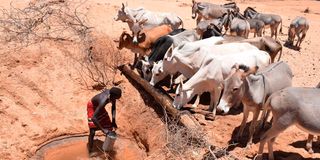Samburu drought could cause more conflicts, drought agency says

A Samburu herds boy watering livestock at Kom area on September 19, 2022.
Long dry spells may result in increased resource-based and human-wildlife conflicts in Samburu as livestock competes for forage and water, the National Drought Management Authority (NDMA) has said.
In recent weeks, there have been reports of boiling tensions brought about by disputes over access to diminished grazing pastures and water points due to a prolonged drought ravaging the region.
On Wednesday last week, two herders were injured after they clashed over control of pasture and water in Nkoriche area in Baragoi.
Samburu North Sub County Police Commander Michael Wachira, who confirmed the incident, said they believe the attack was as a result of scarce resources in the wake of prolonged droughts ravaging the pastoral region.
The NDMA said that deterioration in pasture and browse condition is likely to continue through April 2023 when the March to May 2023 rainfall season is likely set in.
The ongoing drought, the NDMA said, has rendered most families destitute as the majority depend on nomadic pastoralism for livelihoods.
"Resource-based conflicts and human-wildlife conflicts are likely to arise as livestock competes for forage and water," the latest drought update report said.
Also, malnutrition rates for children under five continue to hit the region due to inadequate dietary intake as drought decimates livestock, the region's economic mainstay.
Mid Upper Arms Circumference (MUAC) data for last month show that a proportion of 36.8 percent of the children under the age of five years are at risk of malnutrition in Samburu.
"The proportion of children under five risk of malnutrition based mid-upper arm circumference has continued to remain above usual rates due to dire food insecurity situation, occasioned by the prolonged drought following four consecutive seasons of failed rains," read the report.
"The current prevalence of children at risk of malnutrition was 36.8 percent which is almost equivalent to last month’s proportion of 37.8 percent."
High cases of children at risk of malnutrition were reported in Wamba West, Wamba North, Waso, Ndoto and Nachola wards.
Most households in the region reported taking 1 to 2 meals per day instead of normally 2 to 3 meals a day comprising of cereals, vegetables, milk and oil.
The NDMA also said milk production in Samburu was cut short amid deteriorating animal body conditions. Pastoralists are forced to sell their emaciated animals at throwaway prices or risk losing them altogether to severe famine.
The value of livestock which is pastoralists' main livelihood has deteriorated leading to shortage of milk production.
According to NDMA, the reduction in production has pushed milk consumption to be significantly reduced at the household level and is expected to worsen further as the ravaging effects of the drought persist.
"The shortage of milk has pushed prices up by 50 percent across the livelihood zones. The prolonged drought resulted in poor livestock breeding cycle thus below normal kidding, lambing and calving," said NDMA.
The drought, which officials have termed as the worst in four decades, has threatened the livelihoods of nomadic pastoralists with massive livestock deaths amid lack of water and pastures. The vast arid land is enduring one of its harshest droughts and locals have been pushed into crisis.

